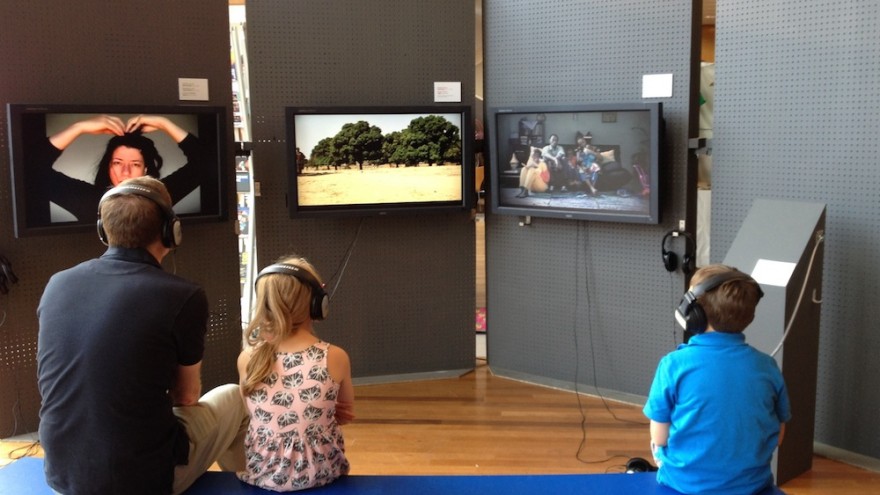For three days at London’s Southbank Centre, the exhibition Digital Africa: The Future is Now featured the work of seven artists whose video pieces and sound art highlighted the experimental nature of new wave African and African diasporic visual art.
Conceived as part of the annual Africa Utopia festival of art and ideas, Digital Africa was curated by Paris-born Christine Eyene, who co-curated the Dak’Art biennale of contemporary African art in 2012.
Eyene is a Guild Research Fellow in Contemporary Art at the University of Central Lancashire, where she is contributing to Making Histories Visible, an interdisciplinary visual art research project. Although her research and curatorial work has centred on contemporary South African art since the late 1990s (including exhibitions on the photography of Gideon Mendel and George Hallett), Eyene possesses a broad vision of African arts and culture. Over the years, she has been involved in artistic shows at the Quai Branly Museum in Paris, Art Basel and the National Gallery of Zimbabwe. Her current project, Basket Case II – co-curated with Raphael Chikukwa, chief curator of the National Gallery of Zimbabwe – pairs Zimbabwean basket weavers with a diverse roster of prominent international artists and designers for workshops and an exhibition in Zimbabwe later this year.
The informal, pop-up style of the Digital Africa exhibition at the Southbank provided Eyene with an opportunity to explore different ways to present digital art for a wide range of audiences.
As a Londoner and a frequent visitor to the Southbank Centre myself, I had a sense of the diversity of audiences those venues attract – from families to break-dancers and, of course, a wide range of culture lovers, says Eyene.
She selected diverse work by a geographically and generationally diverse range of artists from Mali, South Africa, Rwanda, Ghana, Morocco, Mauritius, London and Belgium. All use digitally produced video or sound recordings as their medium of choice.
In South African artist Cecilia Ferreira’s tragicomic video piece, “Belle”, she uses her own face as a blank canvas that ends in a vision of disfigured beauty as layers of make-up are added to show the pressure put on women to conform to ideals of beauty. Eyene has also chosen Ferreira’s work for her upcoming La Parole aux Femmes (Women Speak Out) project at France’s Fondation Blachere, continuing her academic research into the narratives around the female body.
“Alter” by Laura Nsengiyumva, a Rwandan artist living in Belgium, unpicks the ambiguous interaction between a pupil and a teacher. The touching of the student’s hair or patting of the head is seen as affectionate for one but condescending for the other.
Another piece, “1994”, takes a nuanced look at the genocide that took place in Rwanda in 1994. Rather than showing the violence itself, the video shows a young Rwandan family sitting on a couch watching news coverage of the genocide on TV. The piece “is more about exile than the family themselves,” says Nsengiyumva.
Now 27, she was six years old at the time of the conflict. She is representing the Rwandan diaspora in Belgium and beyond as part of a young generation of digitally influenced artists.
It’s really a story about the community and how we saw the Rwandan war in this country through the media, she explains.
Her experience of the event is twice removed – by exile and by the media.
“My parents were the first generation that came for their studies as part of an intellectual diaspora,” she explains. “Then there was the second flow of people coming because of the genocide.”
“Kattu Bateau” by Em’Kal Eyongakpa, a sound artist from Cameroon, is “a rhythmic play on noise, words and repetitions” recorded by the artist in Cameroon’s capital between 2009 and 2012. The sound installation features excerpts from the multilayered piece States[s] project.
In “Tout le Mond s’appelle Mohamed” (“The whole world is called Mohamed”) by Moroccan multidisciplinary artist Younes Baba-Ali, a sudden and abrupt voice calls out the name “Mohamed”. A playful piece by the Belgium-based Baba-Ali, its main purpose was to engage visitors to respond with an almost involuntary reaction.
The piece functioned well “as a disruptive sonic element,” says Eyene.
I observed some people being puzzled by where this intermittent call was coming from by turning their heads toward the source.
But surely, things would play slightly differently in a Gallic context? “Yes,” Eyene agrees. “In France, there’s a large North African community. In the 30 years I lived in Paris since childhood, I always had among my friends at least one who was called Mohamed (or Momo). So, a piece like this presented in Paris, Lyon or Marseille would speak to a good number of passersby. It would also be an important piece in relation to France’s history in North Africa, colonisation and North African people’s liberation, notably in Algeria. One would also wonder how many Mohameds you’d find in a gallery space…”
As an experimental display specifically conceived for the Africa Utopia festival, there are no plans to tour Digital Africa. However, even as a one-off project, there’s strength in the fact that the exhibition shared nearby floor space with a separate, capsule display of Black Chronicles II, an exhibition of portrait photographs taken by the London Stereoscopic Company of the African Native Choir, who toured Britain in 1891-93, shown here publicly for the first time.
This symbolic meeting of the past, present and future of African art and artists seems to represent the huge journey that diasporic African stories have taken, with more and more exciting examples of the aesthetic gaze coming from the eyes of the highly creative, digitally informed subjects themselves.










